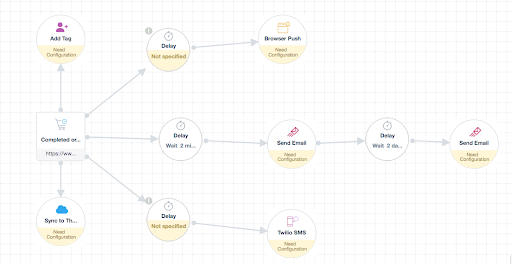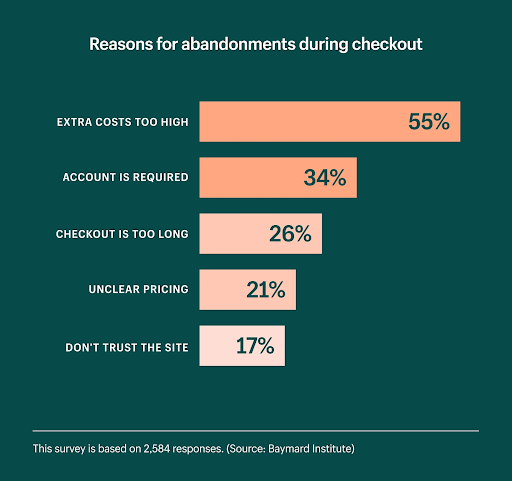User experience is a critical factor in e-commerce. It shapes every aspect of customer’s interaction with a brand and influences their purchasing decisions.
However, there are some issues that could negatively affect your customer’s experience with your brand. According to Econsultancy, 26% of shoppers abandon shopping carts due to a lengthy and complicated checkout process.
One potential solution to this challenge is incorporating payment options directly within forms. By simplifying the checkout process in this way, businesses can enhance the e-commerce experience for their customers.
The rise of payment forms
E-commerce brands have adopted payment forms to streamline the checkout process and circumvent the need for customers to navigate multiple pages. They curate a standalone experience by integrating their product offerings with a unique checkout process. These products can range from tangible goods to digital assets like e-books, whitepapers, or courses. Typically, these forms can display products, oversee shipping, manage billing (one-time and recurring), and facilitate checkout through payment gateways like Stripe.
The marketing impact of payment forms
Ecommerce marketing platforms providing payment forms options allow businesses to acquire several benefits:
Automated messaging and streamlined customer management
Rather than going through multiple tools to track purchases and communicate with customers, you have everything centralized in a single dashboard. For instance, when a customer makes a purchase, the system can automatically trigger subsequent actions. This could include sending an automated message like an email, SMS, or web push notification immediately after the purchase. If you wish to go a step further, the platform supports more advanced actions, one of which is adding or removing a lead from Facebook or Google custom audience.

Higher conversion rates
One of the primary barriers impacting conversion rates is a convoluted user experience. According to the Baymard Institute, 34% of US online shoppers stopped completing their purchases due to unnecessary account creation. In many traditional e-commerce setups, customers navigate multiple pages and provide various details, often revisiting some pages, before they can even add products to their cart and initiate checkout.
Payment forms offer a solution to this cumbersome process. Customers can select products, specify shipping details, choose their billing preferences, select a payment gateway, and complete their purchase—all from a single location. This efficient approach not only encourages quicker purchasing decisions but also increases the likelihood of impulsive buying. Supporting this, Baymard reported that a streamlined checkout design can provide an average large-sized e-commerce site with a 35.26% boost in conversion rate.
Reduced cart abandonment
Shopify reports that for every 100 prospects visiting your website, approximately 67 leave without completing a purchase. Several factors contribute to this high rate of cart abandonment: the necessity of account creation, unexpected and prohibitive costs, a complicated checkout process, concerns over trustworthiness, or unclear pricing.

More transparency
Payment forms consolidate essential details—from product specifications and shipping costs to payment options and gateways— in one simplified checkout experience. This level of transparency ensures customers have a clear understanding of their transactions. Moreover, embedding the checkout in a distraction-free page, reduces the potential for bounce rates.
Optimized for mobile
With the ongoing surge in mobile shopping, the demand for a streamlined, one-page checkout experience has never been greater. Payment forms are tailored to be fully mobile-responsive, ensuring a seamless user experience without the hassles of pinching, zooming, or redundant scrolling.
Faster experimentation
With payment forms, marketing and product teams can launch payment gateways in just minutes, without the need for coding, complex implementations, or even the reliance on a fully-fledged shopping cart system followed by concerns regarding integration. For marketing teams, rapid experimentation isn’t just a benefit – it’s a need.
Who can benefit from payment forms?
Startups and new entrepreneurs
For those embarking on a new business journey, setting up an online store can pose significant challenges. Payment forms emerge as a convenient solution, obviating the need for a comprehensive e-commerce platform. By incorporating payment forms onto landing pages or popups, budding entrepreneurs can swiftly initiate sales without delving deep into intricate website development or complicated shopping cart integrations.
Digital product sellers
Digital products such as ebooks, online courses, or downloadable software take advantage of immediate delivery and this is stimulated with payment forms. When a customer makes a purchase transaction, they can immediately access the product, improving the buyer’s experience. This also reduces potential requests for refunds.
Physical product retailers
For merchants dealing in tangible goods, streamlining the customer’s journey from product discovery to final purchase is crucial for maximizing conversions. Small to medium-sized businesses (SMBs) frequently roll out limited-time promotions or spotlight their signature products. In these contexts, payment forms expedite the checkout process, capturing sales efficiently. Instead of navigating multiple pages, customers can instantly finalize their purchase, mirroring the simplicity of a card swipe in a physical store.
Subscription-based services
In today’s landscape dominated by subscription models, securing long-term customer commitment, typically through recurring billing, is paramount. Payment forms are tailored for this approach, facilitating a seamless sign-up process. With integrated options for one-time or periodic billing, businesses can present unambiguous choices to their customers. Additionally, by retaining payment details, subscription renewals are simplified, guaranteeing steady revenue and reducing churn. For subscribers, the straightforward sign-up process and transparent terms heighten trust and overall satisfaction.
Conclusion
The myriad advantages of payment forms are undeniable, making them an essential consideration for businesses. Customers inherently gravitate towards simplicity, especially in critical areas like finalizing a purchase. By simplifying the process, businesses assure customers of a streamlined and secure experience, subsequently enhancing conversion probabilities. This, in turn, drives more sales and profits. However, it’s crucial to strike a balance — while simplicity is vital, excessively long forms can deter customers, especially those on mobile devices.
Ready to elevate your customer experience? Get started seamlessly with platforms such as VBOUT
Don’t forget to share this article
